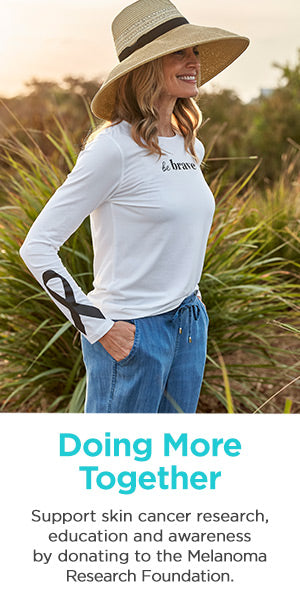Sun Protective Clothing vs. Sunscreen

Compare sunscreen and sun protective clothing side-by-side and then determine how to best protect yourself and your family from the sun.
SPF vs. UPF Ratings
Sunscreen protects skin by absorbing and/or reflecting UV rays. The Food and Drug Administration (FDA) requires that all sunscreens contain a Sun Protection Factor (SPF) label. The SPF discloses the amount of sunburn protection that a sunscreen can provide an average user when used correctly. The American Academy of Dermatology (AAD) recommends sunscreens with an SPF of 30 or higher. Although the SPF ratings found on sunscreen packages apply to UVB rays, many sunscreen manufacturers include ingredients that protect the skin from some UVA rays as well. These sunscreens are usually labeled as “broad-spectrum” and are recommended since both UVA and UVB have been linked to skin cancer according to the Environmental Protection Agency.
Sun protective clothing uses fabric to protect skin from the sun. The fabric is rated according to an Ultraviolet Protection Factor (UPF). UPF is like SPF except UPF rates protection against both UVA and UVB. A garment with a UPF of 50 only allows 1/50th of the UV radiation falling on the surface of the garment to pass through it. In other words, it blocks 49/50ths or 98% of the UV radiation. Sun protection clothing is an easy and reliable form of UV protection and so is becoming more and more popular. Look for garments that have been tested according to American Association of Textile Chemists and Colorists (AATCC) Test Method 183. The best brands also perform complete life cycle tests using American Society for Testing and Materials (ASTM) D 6544. This form of testing tells how garments protect as they age not just when they are brand new.
Sunscreen vs. Sun Clothing Effectiveness
The AAD says for sunscreen to be effective in protecting skin from UV rays, it should be applied to dry skin 15 to 30 minutes before sun exposure. Apply it to all exposed areas and pay particular attention to the face, ears, hands, and arms. One ounce, enough to fill a shot glass, is the amount needed to cover the exposed areas of the body properly. Sunscreens should be reapplied approximately every two hours or after swimming or perspiring heavily.
Coolibar Sun Protective Clothing provides intant coverage. There is no need to reapply anything, except broad-spectrum sunscreen to areas not covered by the clothing. Coolibar’s sun protection never fades or washes out as titanium dioxide or zinc oxide blockers are permanently embedded in many of our material’s fibers. Other items, such as our UV swimwear and hats, are formed with a tightly woven material that offers UPF 50+ protection. Coolibar carefully tests each garment to ensure excellent sun protection.
Physical Sunscreen (SPF 30 broad-spectrum)
Coolibar Sun Protective Clothing (UPF 50+)
Blocks 97% of harmful UVA and UVB rays
Blocks 98% of harmful UVA and UVB rays
Effective when reapplied every two hours or after excessive sweating or swimming
Effective always or for life of garment, no need to replace garment after use
1 oz. of sunscreen (shot glass full) protects skin when rubbed in everywhere
Clothing completely protects covered portions of skin
By using both sun protective clothing and sunscreen you can achieve ultimate protection! Wear sun protective clothing to cover majority of skin and choose a broad-spectrum sunscreen (which blocks UVA and UVB rays) with an SPF of 30 or higher to cover all skin exposed to sunlight. Wear a sun protective hat with a 3” brim or greater to shade your face, ears and neck. Then slide on some sunglasses that block 100% of UV rays or offer UV 400 protection to cover your eyes. Be sunAWARE and be safe.
About Coolibar
For more than 20 years, Coolibar (koo-luh-bar) has stopped at nothing to develop the most technical and elegant sun protective clothing, hats and accessories. The world leader in UPF 50+ fabric technology.


